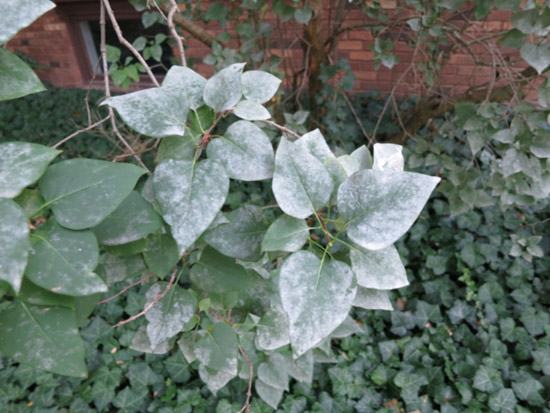Issue 13, July 30, 2012
Powdery Mildews
Powdery mildews are one of the most easily recognized diseases in the landscape. Unfortunately, they are equally as common and can be a problem on annuals, perennials, shrubs, and even trees. Powdery mildews flourish when the days are warm to hot, the nights are cool, and humidity is high. They are often more severe on crowded plants growing in the shade where air circulation is poor.
Powdery mildews are caused by fungal pathogens. Many different species are responsible. The species are grouped in six closely related genera. Most powdery mildews are fairly host specific. Those who are curious about matching a host to the likely powdery mildew involved should consult Table 1 of RPD No. 617: Powdery Mildews of Ornamentals (Adobe PDF).
As mentioned, the disease symptoms are easily recognized and these symptoms also appropriately match their disease name because they first appear as distinctive white powdery patches on shoots, buds, flowers, or stems (first image). The disease progresses to form a felt-like, white mildew growth. Large portions of the plant, especially leaves, may be infected. Late in the season, small spherical, dark brown-to-black fungal structures (cleistothecia) may be seen mixed within the felt-like mildew (second image). Some infected leaves may display symptoms of stunting, curling, chlorosis, and premature leaf drop.

Powdery Mildew on Lilac. Shrub was located in a fairly shady location.

Oak leaves infected with powdery mildew. Close inspection reveals tiny, dark, cleistothecia.
Damage from powdery mildew is mostly aesthetic and in most situations will not harm the long-term health of the plant. Death of infected plants is rare. However, flowers may be reduced in number and quality due to this disease. The powdery mildew covering the leaves may also lower the plant's photosynthetic efficiency, resulting in reduced growth. Infections have also been associated with increased winter injury to perennials.
Control Recommendations
- Purchase plants that are healthy and disease free. When available, select cultivars that are resistant.
- Avoid planting susceptible species in shady areas with poor air movement.
- The pathogen thrives in humid conditions.
- Dense plants may need to be pruned to promote airflow.
- Improper watering can promote the disease. Focus watering from below and avoid splashing water on the leaves. Water early in the day to allow the foliage to completely dry.
- Fungicides can be used to preventatively to control powdery mildew. Applications should be started at first appearance of the disease and reapplied according to product label directions. Fungicides labeled for homeowners can be found in the University of Illinois Extension Pest Management for the Home Landscape book. Commercial applicators should consult the 2010 Commercial Landscape and Turfgrass Pest Management Handbook for approved fungicides.
(Travis Cleveland)
Author:
Travis Cleveland